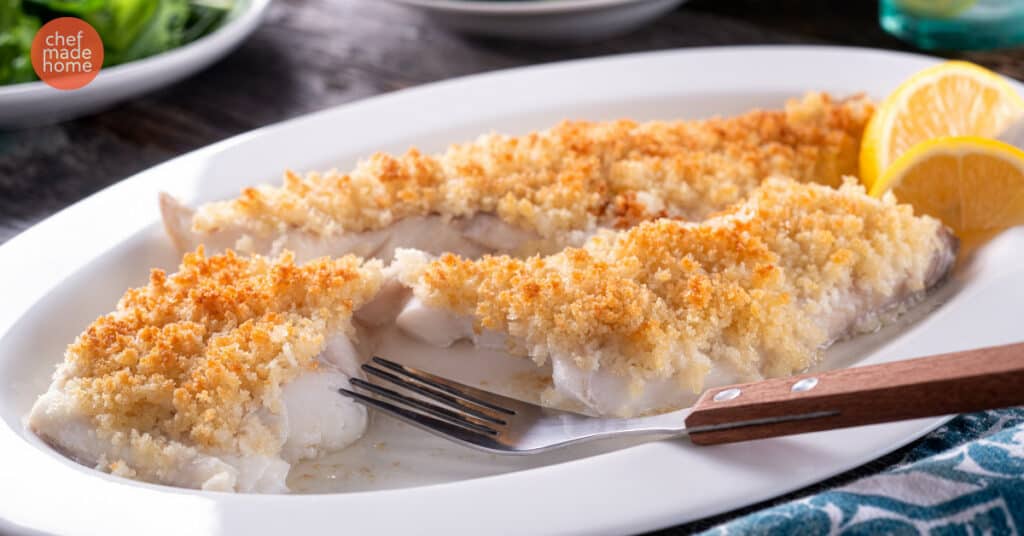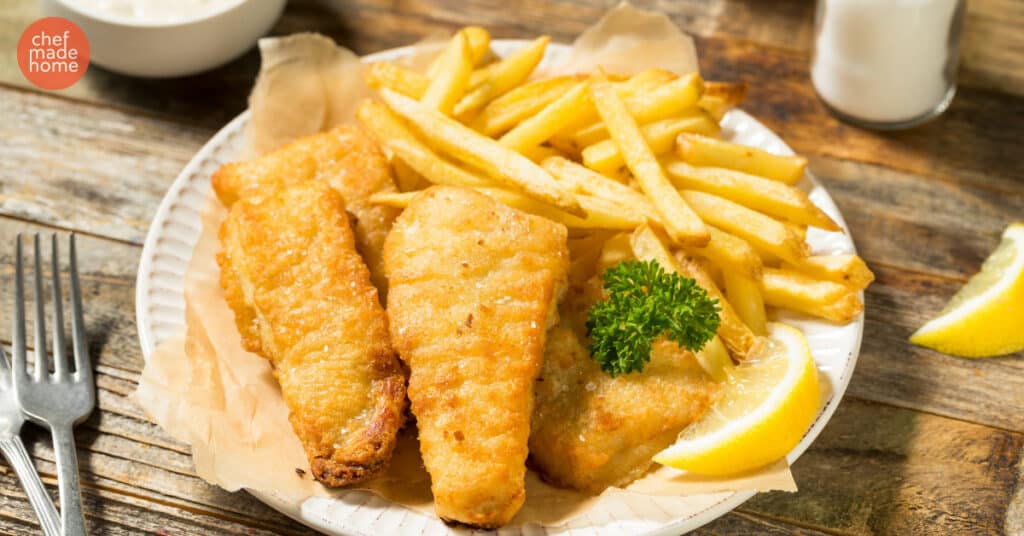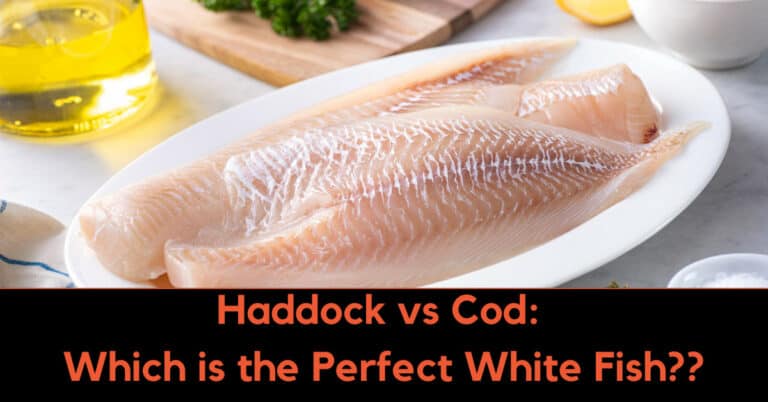SUMMARY: Haddock and cod are both popular types of white fish, but they have distinct differences in taste, texture, and nutritional value. While haddock is milder with a flakier texture, cod has a firmer texture and a slightly sweeter taste. Ultimately, the choice between haddock and cod comes down to personal preference and the desired flavor profile for a dish.
Do you find yourself torn between haddock and cod when choosing the perfect white fish for your meals?
If so, you’re in the right place. Today, we’ll settle the haddock vs cod debate once and for all as we explore these two seafood contenders’ distinct qualities and flavors. From their taste and texture to their culinary uses and sustainability, join me as we dive deep into the world of haddock and cod.
Teaser bullet points for the upcoming subtopics:
- The Cod Contenders: Discover the various cod species and what makes True Cod stand out.
- Haddock: The Challenger Approaches: Learn about Haddock’s unique characteristics and its role as a worthy competitor.
- Taste Test Throwdown: Get ready for a delicious exploration of the flavor, texture, and aroma differences between Haddock and True Cod.
- Health and Sustainability: Uncover the nutritional benefits, environmental considerations, and sustainability factors of both haddock and cod.
Stay tuned as we embark on this mouthwatering journey filled with insightful comparisons and personal anecdotes about haddock and cod.
The Many Types of Cod

Cod is undoubtedly a heavyweight in the world of seafood, with numerous species under its belt. Let’s take a closer look at the intriguing world of cod and focus specifically on True Cod, the star of our comparison. Here’s what you need to know:
Overview of Cod Species
- The Atlantic Cod (Gadus morhua) is the most well-known and widely consumed type of cod.
- Pacific Cod (Gadus macrocephalus) is also highly regarded for culinary qualities.
- Other notable species include Greenland Cod, Poor Cod, and Rock Cod, each with distinctive characteristics and uses.
Meet True Cod
True Cod, known scientifically as Gadus or simply Cod, refers to specific species within the cod family. Gadus morhua, the Atlantic Cod, and Gadus macrocephalus, the Pacific Cod, are the primary contenders in our comparison.
Characteristics of True Cod
- True Cod typically has a longer and slimmer body than other cod species.
- Its coloring can range from olive green to brownish-red, and the fish often has a speckled appearance.
- True Cod features a firm, slightly flaky texture, and a mild, clean flavor profile.
Culinary Significance
- True Cod has a rich history and is vital to culinary traditions worldwide.
- It is renowned for its versatility in cooking, as it can be baked, grilled, sautéed, or used in soups, stews, and traditional fish and chips.
Stay tuned as we explore the challenger, haddock, in the next section!
Haddock
Introduce haddock as a formidable competitor
Haddock, a close relative of cod, is another popular white fish that deserves recognition for its unique qualities and culinary uses. While often overshadowed by its cod counterpart, haddock has a distinct flavor and texture that sets it apart as a formidable contender.

Highlight haddock’s distinct qualities and culinary uses
- Superior texture: Haddock is known for its firm yet flaky texture, making it an excellent choice for various cooking methods. Its flesh holds together well, making it easy to work with in recipes that call for frying, baking, or grilling.
- Delicate flavor: Haddock boasts a subtle, sweet taste slightly milder than cod. This makes it a versatile fish that can be seasoned and paired with a wide range of flavors, allowing it to shine in various dishes.
- White appearance: Unlike cod, haddock features pure white flesh that retains its bright color even after cooking. This visual appeal adds an attractive element to the presentation of your culinary creations.
Comparison of haddock’s flavor profile with that of True Cod, noting any noticeable differences
A few key differences emerge when comparing the flavor profiles of haddock and True Cod. Haddock tends to have a slightly sweeter, milder taste compared to the more pronounced flavor of True Cod. While both fish have a fresh flavor, haddock’s delicate notes make it an attractive choice for those who prefer a subtler taste. However, it is essential to note that individual palates may vary, and personal preferences ultimately dictate the preference for one fish over the other.
Like True Cod, Haddock is versatile in cooking and pairs well with various seasonings and ingredients. Its delicate flavor allows it to assimilate the flavors of herbs, spices, and sauces without overpowering them, making it an excellent choice for simple and complex recipes. From classic fish and chips to creamy chowders and delicate seafood stews, haddock has made a name in various traditional and contemporary dishes.
In the next section, we will dive into a detailed comparison of the taste, texture, and aroma of haddock and True Cod, allowing you to make an informed decision based on your culinary preferences. Join us as we explore the ultimate taste test throwdown between these two beloved white fish varieties.
Taste Test Throwdown
Dive into a detailed comparison of haddock and True Cod regarding taste, texture, and aroma.
When it comes to the ultimate taste test, comparing the flavor, texture, and aroma of haddock and True Cod is essential. Let’s delve into each aspect to determine their unique characteristics and how they influence each delicious white fish’s cooking methods and recipes.
Taste
- Haddock:
- Delicate and slightly sweet flavor
- Subtle notes enhance the taste of seasonings and complementary ingredients
- It has a milder taste compared to True Cod, appealing to those who prefer a less pronounced fish flavor
- True Cod:
- Clean and mild flavor with a slightly more assertive taste than haddock
- Ideal for those who enjoy a more distinct fish flavor
- Adaptable to a wide range of seasonings and sauces
Texture
- Haddock:
- Firm yet flaky texture
- Holds together well during cooking, making it suitable for various preparations
- Moist and succulent when cooked, ensuring a satisfying eating experience
- True Cod:
- Tender and flaky texture, but slightly more delicate than haddock
- Falls apart quickly when cooked, making it suitable for specific recipes such as poaching or gently sautéing
- Smooth and silky mouthfeel, contributing to its overall appeal
Aroma
- Haddock:
- Mild, clean aroma with subtle hints of the ocean
- Doesn’t overpower the senses, allowing other ingredients to shine
- The pleasant, inviting scent when cooked
- True Cod:
- Fresh and appealing sea-like aroma
- It has a slightly deeper and more pronounced smell compared to haddock
- Sweeter smell during cooking
Exploring the differences in taste, texture, and aroma helps us understand the characteristics that make haddock and True Cod unique. These factors also play a crucial role in determining each fish’s ideal cooking methods and recipes. Whether you prefer the delicate and slightly sweeter flavor of haddock or True Cod’s clean and mildly assertive taste, there are numerous ways to enjoy the distinct qualities of these white fish varieties.
In the next section, we will provide personal anecdotes and experiences related to haddock and True Cod, sharing insights into popular dishes, cooking methods, and recipe considerations. Stay tuned as we dive deeper into the culinary world of these flavorful fish options.

Health and Sustainability
Discuss the nutritional benefits and drawbacks of haddock and cod
When considering the health aspect of consuming haddock and cod, evaluating their nutritional benefits and potential disadvantages is important. Let’s explore the key factors that make these white fish options both nutritious and potentially concerning.
Nutritional Benefits
- Haddock:
- Excellent source of high-quality protein, supporting muscle growth and repair
- Rich in essential nutrients such as vitamin B12, selenium, phosphorus, and potassium
- It is low in calories and fat, making it suitable for individuals watching their weight or following a low-fat diet.
- Provides omega-3 fatty acids, which benefit heart and brain health
- Cod:
- It is a good source of protein, essential for building and maintaining healthy tissues.
- Contains beneficial nutrients like vitamin B12, phosphorus, and selenium
- It is low in calories and saturated fat, making it a nutritious option for various dietary needs
- Contains omega-3 fatty acids, supporting heart health and reducing inflammation
While both haddock and cod offer similar nutritional benefits, it is worth noting that the specific nutrient composition may vary slightly. However, both fish can be part of a well-balanced diet that provides essential vitamins, minerals, and omega-3 fatty acids.
Sustainability Considerations
- Haddock:
- Considered a sustainable choice in certain regions, such as the Northeast Atlantic and North Sea
- Stocks are well-managed, with regulations in place to prevent overfishing
- Some concerns exist regarding specific haddock stocks, particularly those in the North Sea, so it’s essential to check local sustainability guidelines
- Cod:
- Varies widely in terms of sustainability depending on the species and geographic region
- Some cod stocks, such as Atlantic cod in the Northwest Atlantic, are overfished or in an overfished state.
- Sustainable fishing practices and adherence to certification programs such as MSC (Marine Stewardship Council) are crucial in supporting the long-term health of cod populations.
Being mindful of the environmental impact of our seafood choices is vital for the long-term sustainability of our oceans. It is recommended to refer to reputable sources and local sustainability guidelines to ensure that the haddock and cod you consume are from well-managed stocks.
Another great source for checking on the sustainability of your seafood choices is the Monterey Bay Aquarium Seafood Watch.
Key Takeaways
In conclusion, the haddock vs cod debate has allowed us to explore the distinct characteristics and flavors of these two popular white fish varieties. Here are the key takeaways from our discussion:
- Haddock and True Cod are both highly regarded white fish, each with unique qualities.
- With its various species, True Cod holds a significant place in culinary traditions and is widely consumed worldwide.
- As a formidable challenger, Haddock offers distinct flavors and versatility, making it a popular choice in many recipes.
- Taste, texture, and aroma are crucial in determining the cooking methods and recipes for haddock and True Cod.
- Considering the nutritional benefits, sustainability, and environmental impact, haddock and cod provide seafood enthusiasts with viable choices.
Thank you for joining us on this journey of exploring haddock and cod. Our insights have shed light on the differences between these two delectable options, enabling you to make informed decisions based on personal preferences, culinary requirements, and sustainability concerns.
FAQs
What is the main difference between haddock and cod?
The main difference between haddock and cod is their flavor profile and texture. While both are white fish, haddock has a slightly sweeter taste and more delicate texture compared to cod’s firmer, milder flavor.
Which fish is more suitable for grilling?
Both haddock and cod can be grilled, but I wouldn’t try. They are better suited to being baked or broiled. However, if you really want to grill then go with Cod as it holds its shape better.
Are haddock and True Cod interchangeable in recipes?
In most recipes, haddock and True Cod can be used interchangeably. However, it is important to consider their distinct flavors and textures. Haddock’s sweeter taste and delicate texture are more suitable for certain dishes, while cod’s milder flavor and firmer texture work better in others.
What are some popular dishes that feature haddock or cod?
Popular dishes featuring haddock include fish and chips, haddock chowder, and haddock fillets baked in various sauces. Cod is commonly used in words such as fish tacos, fish cakes, and cod au gratin.
Are there any concerns regarding overfishing with haddock or cod?
Both haddock and cod have experienced overfishing, leading to concerns about their sustainability. However, strict regulations and sustainable fishing practices have been implemented to protect and rebuild their populations.
Can haddock or cod be substituted with other types of fish?
Yes, haddock and cod can often be substituted with other white fish with similar characteristics and flavors, such as pollock or hake. However, the substitution should be carefully considered to ensure the desired outcome regarding taste and texture.

